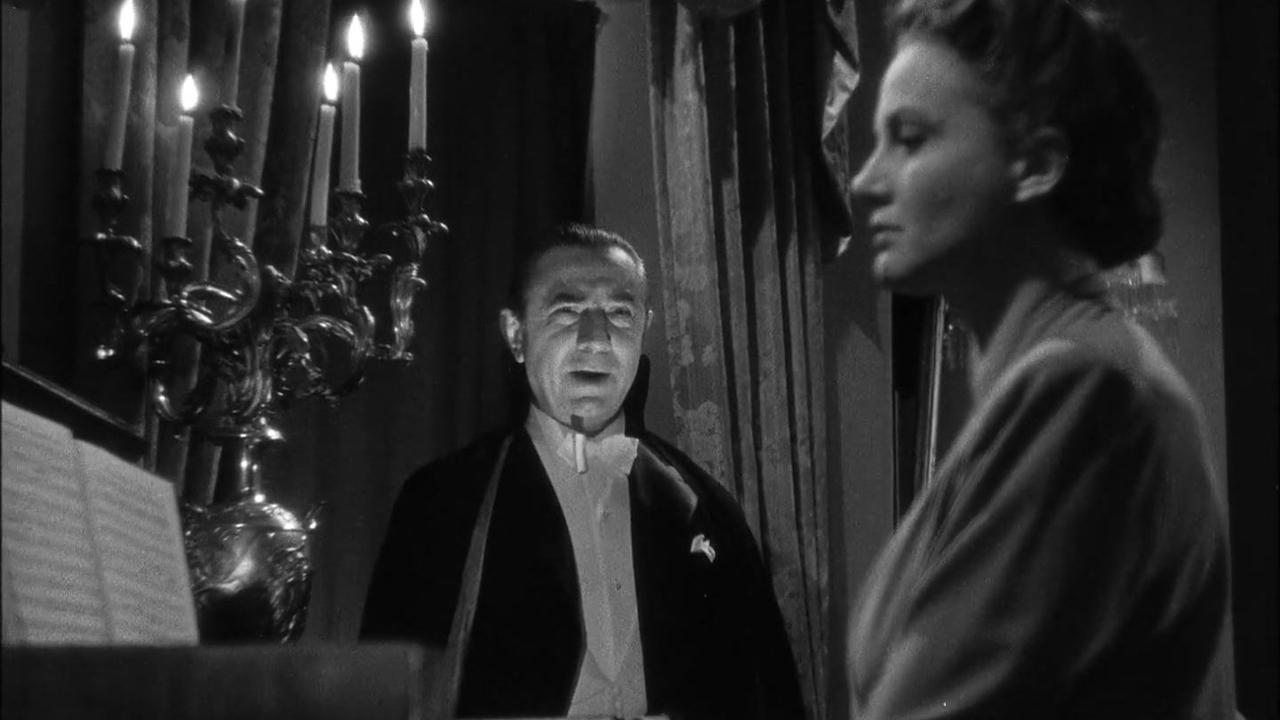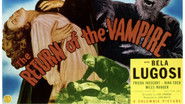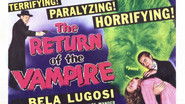Cineanalyst
Released on the heels of Universal's first monster-rally movie, "Frankenstein Meets the Wolf Man" (1943), as well as the third film in the studio's Dracula series, "Son of Dracula" (1943), Columbia decided to make its own monster rally, which could've appropriately been titled, "Dracula Meets the Wolf Man." Adding to the studio and character crossovers, Bela Lugosi, the vampire of this film, "The Return of the Vampire," played the Frankenstein monster in "Frankenstein Meets the Wolf Man," and the Wolf Man from that film played Dracula in "Son of Dracula." Additionally, director Lew Landers had directed the classic Universal horror film "The Raven," which starred Lugosi. At this point of B-production shockers of the 1940s, no studio was making vampire pictures that had really anything to do with Bram Stoker's novel "Dracula," though, and most of them are a far cry from the classic 1930s Universal monster movies, which began with Lugosi's "Dracula" (1931). Columbia's "The Return of the Vampire" is better in some ways than some of the contemporary Universal shockers, though.There are some interesting details for those who follow the genre. Lugosi's face isn't revealed until 23 minutes in--building up suspense in the meantime. In the first scene, we mostly just see his shadow (Stoker's Dracula casts no shadows. "Nosferatu" (1922) added shadows.). The vampire bites a child--something Dracula never did, although the female vampires would (although in film, Hammer's 1958 "Dracula" may've been the first to show one of the female vampires attacking children). The vampire is resurrected by the stake being removed from his heart. Perhaps, Universal wanted to pay Columbia back a bit for their borrowing from Universal's monster movies, and that's why they use this trick to bring Dracula back in the next year's "House of Frankenstein."I like that the second Van Helsing-type doctor, after her originally being a skeptic, is a woman this time. It's possibly the first time a leading actress wasn't a vamp or a victim in a vampire film. I'm less fond of seeing a werewolf fight with his fists and barely escape a scrape with two men, or to see him die from what one assumes is a normal bullet. But, at least, he wrestles with his good human nature and his evil wolfman enslavement, and he's the one who ultimately defeats the vampire, so it's a satisfying monster- rally finish. Plus, this vampire is triply strong; literally, it, apparently, takes three of his usual weaknesses--stakes to the heart, crosses, sunlight--to finish him off.Stylistically, there's a big emphasis on fog. It even follows the vampire inside, and it's constantly spread throughout the frequent graveyard scenes. They use an upward-tilted light to shine in Lugosi's face--reminiscent of Karl Freund's highlighting of Lugosi's eyes in the 1931 "Dracula." The narration is all over the place--beginning with a title card that introduces the milieu, followed by a voice-over that describes the story as based on the notes of a guy who dies after about 15 minutes into the film, which begs the question of who's narrating the rest of the movie. There's also a vampire book, as there had been in other vampire films, such as "Nosferatu," "Vampyr" (1932) and "Son of Dracula." The narrative begins with scientists, but turns to a religious surprise in the final act. There's a constant flow of believers in and skeptics of vampires, with characters changing roles, until, in the final shot, a character turns to the camera and breaks the fourth wall, asking, whether we believe in vampires.Here, vampirism becomes an allegory for German invasion, which is an interesting turn from Stoker's rather xenophobic novel about a foreigner stealing Englishwomen. The film begins with the swift killing of the vampire, coinciding with the end of WWI in 1918. He's resurrected after the Nazis of WW2 bomb the graveyard, among other things, digging up his coffin from its burial. I suppose, then, that when the character at the end turns to the camera, he's asking whether we believe Germans are vampires.(Mirror Note: A small mirror is used to confirm the vampire. Interestingly, the mirror shot shows the vampire's clothes, while not the reflection of his face. Most other movies are content with the confusion of whether vampire's clothes are also vampiric. Not so here.)
Smoreni Zmaj
For it's own time and genre, this movie is simply perfect.10/10Multilayered and deeper than in any previous Dracula movie, story is balancing between drama and thriller. Characterization has much more attention than in any other monster movie from this period, acting is solid, and camera, directing and effects are superb. True masterpiece.
DPMay
From about 1931 to 1945, Universal Studios produced a rightly-famous run of monster-based horror films which have contributed greatly to the whole genre within the public consciousness. Among them was "Dracula" (1931) with Bela Lugosi in the title role, which forever cemented the image of Bram Stoker's character as an elegant man in a flowing black cape.With the character in the public domain, Columbia Studios apparently wanted to do a sequel of sorts with Lugosi reprising the role but the threat of possible action from Universal led to Columbia shifting their plans somewhat and so the vampire that Lugosi plays in this film is named Armand Tesla. But make no mistake, he is Count Dracula in all but name.Made relatively cheaply, even for the time, it would be a bit of a stretch to label this film a classic, but nevertheless it stands as an effective, solid and occasionally innovative horror flick of its era.The story commences with a prologue sequence set in 1918 which depicts how the vampire, wreaking his accursed evil in London, is put to rest by scientist Dr Saunders and his assistant Lady Jane Ainsley. Fast forward about 25 years to the midst of World War II. Dr Saunders has recently died and Scotland Yard Commissioner Sir Frederick Fleet is discussing with Lady Jane his concerns about revelations in the late doctor's private notes concerning driving a stake through the vampire's heart all those years earlier. In spite of Lady Jane's assurances, Fleet is of the opinion a murder may have been committed and is of a mind to exhume the body.However, events move ahead of him. A German bombing raid disturbs the body of the vampire and Tesla wastes no time in picking up where he left off. Developing an unhealthy obsession with Saunders' beautiful daughter Nicki, he resolves to take her back to his homeland and keep her as his eternal bride. But can Lady Jane and a disbelieving Sir Frederick possibly stop him in time?If Bela Lugosi wearied of playing vampires, he doesn't show it here and produces the same type of commanding performance that originally endeared him to the movie-going public in Dracula. Sadly we don't see him bearing his fangs, nor is there any changing into a bat. Instead, Tesla exhibits the power of mind control and, curiously, has the power to not only bring a man under his influence but also to turn him into a werewolf!This means that instead of a deranged sycophant played by Dwight Frye, we have Matt Willis as the rather unwilling henchman to the vampire, Andreas. His werewolf make-up, although elaborate, unfortunately looks more comical than menacing. As might be expected, the transformations are achieved by a rapid series of cross-fades (as with the Lon Chaney Jr Wolf Man films of the same period) but these are generally executed rather better than those witnessed in the Universal films.Quite unusually, it is not the dashing young fiancé of the vampire's victim who is the hero here, nor is it the police commissioner, rather it is Lady Jane, a mature female scientist played by Frieda Inescort. Credit to Columbia for going with a strong, intelligent female lead character at a time when such things were practically unheard of! Being set in London, the majority of the characters speak in overly clipped tones or else exaggerated stone-the-crows-type cockney accents, which hasn't helped the film to age well. And sadly it retreads a lot of familiar ground - you know, teeth marks being found in the victim's neck and all that, but I suppose that's what audiences expected, even wanted. At least we do get to see Lugosi actually rising from his coffin in this film, something that was glaringly avoided back in Dracula. And the backdrop of the war is relevant to the plot rather than serving as mere window dressing.A little more depth wouldn't have gone amiss, and some of the humour tends to undermine the piece but overall the plot hangs together well, the dialogue and imagery are sufficiently strong and the film gives Nina Foch her first big screen role in a career which was to endure for sixty years. There are many worse films to be found, and sadly the great Bela Lugosi would end up starring in some of them.
John T. Ryan
.........BUT THEN AGAIN sometimes it far surpasses anything that we would expect. Such is the case of this Columbia 1944 release of THE RETURN OF THE VAMPIRE. Normally, one could understandably prejudge the movie on several levels.FOR ONE, IT is not a product of Universal Pictures; which of course, we all know is the home of truly "Classic" horror flicks. Didn't Carl Laemmle's studio bring us the Lion's share of cinematic frights dating from the days of the Silents? WAS NOT THE star, Mr. Bella Lugosi over the hill, with some even believing him to have passed away? WELL, THIS EXPECTED bit of schlock double crossed everybody and proved to be an excellent reworking of the legend of "The Undead, the Nosferatu." It was and is a solid, intelligent and near "A" class production. If not truly a "B" picture pot-boiler (produced to fill out the bottom portion of a Double Feature); but rather it is a "B+" movie.TO BE SURE, there are many aspects of the movie that are very likely intended to capitalize on Mr. Lugosi's signature role as Dracula (Universal, 1931). First of all, the very appearance of Armand Tesla (Bella) is virtually the same as his image as Drac, 13 years earlier. From his Top Hat, white bow tie, Tux and fancy cape, Tesla is the spittin' image of the famous Transylvanian Count.EVEN THE TITLE has a certain suggestive ring to it. The very careful crafting of "...THE VAMPIRE", rather than "......A VAMPIRE" would seem to subliminally suggest Dracula; who is after all THEE Vampire of Vampires.ONE THING THAT we have always admired, ever since having first seen this movie on WBKB TV's "SHOCK THEATRE", circa 1957*, is the make-up devised for actor Matt Willis's portrayal of Andreas. He, like Renfield in Bram Stoker's original Dracula is a "Familiar"; that being a poor soul who is enslaved to be a servant to the Vampire. In this case, unlike Dwight Frye's character, Andreas takes the form of a Werewolf when doing the beckoning of the undead one. This Werewolf make-up is as good an interpretation as any cinematic lycanthrope that there is. WHAT REALLY IS surprising and very fulfilling to this film's total impact is a surprising ending. The climax is a highly charged scene featuring the final triumph of Good over Evil.IN THE YEAR of Our Lord 1944, we all needed a positive charge like this; which is not unlike something right out of the Bible.NOYTE: * The local Chicago "SHOCK THEATRE" was hosted by Terry Bennett, whose 'Marvin' character was the Windy City equivalent of Zacherly or Vampira in the other big markets.



 AD
AD





